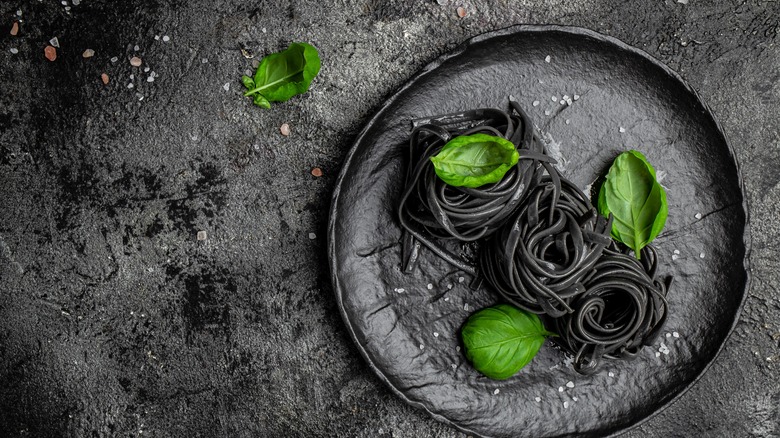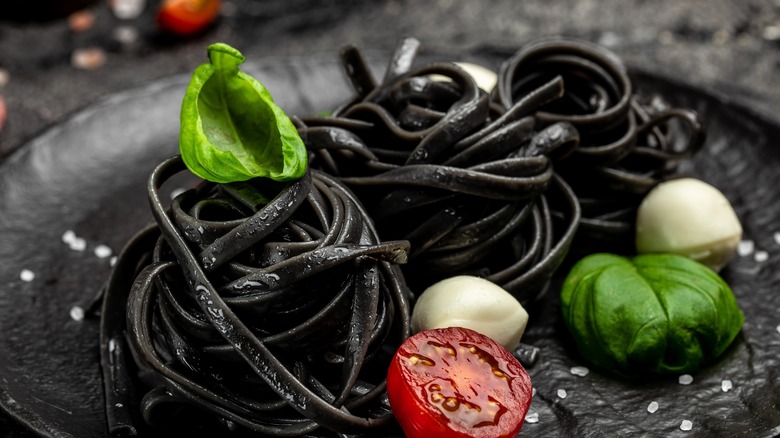Why Bobby Flay Loves Adding Squid Ink To His Pasta Dough
It's safe to say that Bobby Flay knows his pasta. The chef and TV personality has spent much time in Italy and even has his own Italian restaurant, Amalfi, at Caesar's Palace in Las Vegas. If you visit the restaurant, you will have the opportunity to try Flay's squid ink fettuccine served with lobster and shrimp. The black pasta instantly makes a visual impression, but that's not the only reason Flay likes to add squid ink to his pasta dough.
Ultimately, it's all to do with the flavor of the ink, according to Food & Wine. In particular, Flay is a big fan of the saltiness and brininess the ink gives the pasta dough. It infuses the pasta dough, which generally can be mild, with an extra pop of flavor. It also helps create a certain flavor profile when combined with seafood like shrimp or other shellfish. Additionally, Flay is a big fan of how it hides any color changes that oxidation may cause in his pasta after storing it.
In a tour of his pantry by Misfits Market, Flay further explained, "This is some squid ink pasta; shells that I use when I'm cooking shellfish and stuff like that. It's also black pasta, so it's very cool. Good flavor, a little briny."
Squid ink's popularity is growing
Bobby Flay's love for squid ink in his pasta may have originated from his travels to Italy. However, what is certain is the dish has a history in Italy, and the popularity of the black pasta has grown in recent years. Using squid ink in food has been prevalent in both Japanese and Mediterranean cooking. In particular, squid ink has been used as a sauce to form Spaghetti al Nero di Seppia, not to be confused with the popular zucchini spaghetti dish Spaghetti alla Nerano. The latter is particularly popular along the Amalfi Coast, which Flay visited and consequently named his restaurant.
Spaghetti al Nero di Seppia combines pasta noodles with black squid-ink sauce for a briny take on classic spaghetti. Fishermen popularized the dish along coastal towns from the southernmost region of Sicily — where it is believed to have originated — to Veneto up in the northeast. Historically, fishermen would use the ink from either squid or cuttlefish in their pasta to reduce food waste. The dish has now caught on overseas with fine dining restaurants such as Flay's serving the pasta as a delicacy.
Tips and tricks for squid ink pasta
Making squid ink pasta isn't too different from making traditional pasta. You'll need many of the same ingredients, including flour and eggs. When making squid ink pasta, keep in mind that a little ink goes a long way. You'll only need a few teaspoons to make a batch of spaghetti noodles, so consider the measurements and be sure not to add too much. You want a subtle brininess, not a mouthful of salt water.
When mixing the squid ink with your dough, it may be best to add the ink and eggs together. What to be careful of is making sure your squid ink evenly mixes into the flour for a consistent color. Otherwise, your pasta may become spotty with the ink not thoroughly distributed. Another thing to consider is how much seasoning you add to your pasta when cooking. Since squid ink is already salty, you may want to reduce the amount you use or not add any extra at all. Then serve the squid ink pasta with a simple seafood dish or basic tomato and garlic sauce. When in doubt, ask yourself what Bobby Flay would do.


